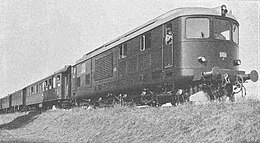Gas turbine locomotive
Gas turbine locomotives are railroad traction vehicles that use a gas turbine as the main drive .
history
The idea of the gas turbine locomotive came from Switzerland , where as early as 1938 the SBB Am 4/6 1101 was the world's first vehicle for test purposes. In contrast to diesel locomotives , gas turbine locomotives also made it possible to burn cheap heavy oil , which at the time was a waste product in oil refineries. The comparatively low power-to-weight ratio of the gas turbine also promised the construction of very powerful locomotives that would be superior to oil-fired steam locomotives in terms of performance and economy. When the production costs for bunker oil C rose in the late 1960s thanks to improved technologies in the refineries, the operation of gas turbine locomotives became uneconomical. There was therefore no further development of the vehicles.

In the late 1940s, which showed US railroad company Union Pacific Railroad interest in the technology. With the participation of General Electric (GE), the American Locomotive Company (ALCO) built the prototype GE 101, which the Union Pacific put into service in 1948 and designated the UP 50. A first series of 10 locomotives was delivered from 1952, another 45 gas turbine locomotives followed by 1961. In the 1960s, the United Aircraft Corporation developed high-speed trains with gas turbine drives for the Northeast Corridor ( Washington - New York - Boston ) . The UAC TurboTrains each consisted of two power cars and a different number of intermediate cars. The Canadian National Railway (CN) ordered five of these trains .
In 1952, the French company Régie Nationale des Usines Renault (RNUR) presented the first gas turbine locomotive with the 040 GA . The two locomotives of the CC 80000 series followed this one-off in 1959 and 1961 . The technology achieved its breakthrough in France with the multiple units of the ETG and RTG series known as Turbotrains . The successor to the prototype TGV 001 , however, were the electric TGV high-speed trains.

In 1949 the Schweizerische Lokomotiv- und Maschinenfabrik (SLM) and Brown Boveri built a locomotive whose electric motors obtained their energy from a gas turbine ( No. 18000 ); In 1951 Metropolitan-Vickers also built a machine ( No. 18100 ) with a turbo-electric drive . The 18000 was used by British Railways (BR) in front of express trains until 1960. With the English Electric GT3 , a gas turbine locomotive with a mechanical drive was built in Great Britain in 1961 , the appearance of which was reminiscent of a steam locomotive. Since the BR saw no further need for turbine locomotives, the concept was not pursued any further. In 1975, the ATP E, a gas turbine multiple unit, was presented, but it did not go into series production.

In Germany, gas turbine technology was used in the early 1970s. To increase their output, the diesel engines of four power units of the VT 11.5 series ( TEE multiple units ) were replaced by gas turbines ( 602 series ). Eight class 210 locomotives were built for heavy passenger train service on the non-electrified, winding route from Munich to Lindau . They had a gas turbine that could be switched on when the power requirement increased. This technology has been tested in the test vehicle V 169 001 since 1965 .
After gas turbine technology had already disappeared from the tracks, the Russian Railways (RŽD) showed interest in it again in the 2000s. In 2007, the ГT1-001 was the first test locomotive, which was followed in 2013 by the ГT1h-002, the first series locomotive of the ГT1 series .
Types
- SBB on 4/6
- UAC TurboTrain
- SNCF 040 GA
- SNCF CC 80000
- SNCF Turbotrain ( ETG and RTG )
- SNCF TGV 001
- DB class 602
- ČSD series TL 659.0
- Bombardier JetTrain
- Union Pacific Railroad gas turbine locomotives
- GT1 of the Russian Railways
- English Electric GT3
UAC TurboTrain (1969)
British experimental train ATP E
Web links
Individual evidence
- ^ Frédéric Didelot: 040 GA et 060 GA: Des prototypes sans descendance . In: Ferrovissime . May / June 2019, No. 99 , 2019, pp. 12 ff .







